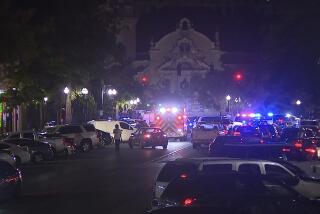Gun Buy-Back Plan Urged to Fight Crime : Violence: Police Chief Bob Burgreen wants to use donated money to pay the public for its working guns, and to buy and distribute trigger locks.
To stem a flood of violent crime that has made this year the city’s deadliest, the San Diego Police Department plans to buy handguns from the public and provide free trigger locks beginning next year, Police Chief Bob Burgreen said Tuesday.
Following the lead of several other big-city law enforcement agencies, Burgreen wants to distribute $50,000 in privately donated money to those who bring in workable guns, and use $15,000 more to buy and distribute free trigger locks.
Two private, nonprofit corporations have expressed interest in donating the money. Burgreen said he hopes to reach an agreement by February. He declined to name either entity.
Although details have not been made final, the chief says he wants to pay $50 for each new or near-new gun and something less for used weapons. Departments in other cities have balked when gun dealers tried to unload scores of junked guns.
With a budget of $65,000, the San Diego Police Department could buy at least 1,000 guns and 1,000 trigger locks, Burgreen said.
As of Tuesday, the city had 168 murders and 180 homicides, which include accidental shootings or those ruled justified by the district attorney’s office. The previous records, set in 1988, were broken in late October.
Police agencies in San Francisco, St. Louis, Rochester, N.Y., Washington, Philadelphia and other locales already have established similar buy-back programs, and more are in the works. Philadelphia police collected more than 1,000 guns in two weeks; St. Louis authorities received nearly 7,500 in one month.
“The first two weeks, we got inundated with non-operable weapons, and it ate up all our budget so we had to revise it and accept only working guns,” St. Louis Officer Paul James said.
Private sources contributed more cash, but it, too, ran out. The St. Louis buy-back program ended Nov. 13, exactly one month after it started. Working pistols had fetched $50; rifles and shotguns $25. About $200,000 was distributed in all.
San Francisco police collected 1,570 guns and handed out $78,500 in confiscated drug money during the seven weeks of its program, which ended Dec. 13. Another $3,000 in private money will be distributed the first week in January as part of a special one-time outlay, San Francisco Police Lt. Thomas Lang said.
San Francisco’s program was not without its pitfalls.
“We certainly didn’t get the guns from the dope dealers and gang members,” he said. “We had a lot of gun dealers try and rip us off, I think. They were giving us guns they could not unload.”
Critics of the buy-back programs say the purchase of guns has virtually no effect in fighting crime because hard-core criminals with sophisticated weapons are unlikely to sell, much less approach a police station. For the most part, they argue, guns are being grabbed from backs of closets and dusted off for a quick buck.
“The obvious criticism implied is that these programs are used by those who are not likely to misuse weapons in the first place,” said Norm Stamper, executive assistant San Diego police chief. “At the same time, these programs have a sizable public relations value and raise the consciousness about crime and violence.”
“I don’t look for it to transform the picture of crime in the community,” Stamper said of the buy-back program.
Although other departments have bought back guns, few have distributed trigger locks to keep guns from firing. Burgreen envisions having gun owners bring their weapons to an area where they are given a brief course on how to install the locks before they are distributed.
“If you are keeping a gun in your home, at least we can help keep it safe,” he said. “I think it will help save lives and cut down on accidental shootings or heat-of-passion shootings.”
More to Read
Sign up for Essential California
The most important California stories and recommendations in your inbox every morning.
You may occasionally receive promotional content from the Los Angeles Times.









